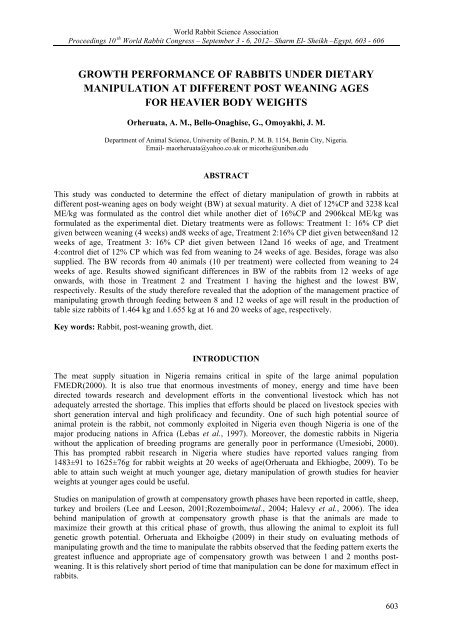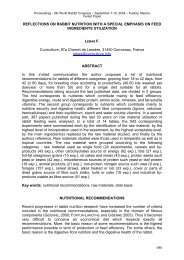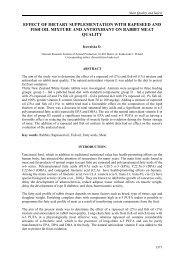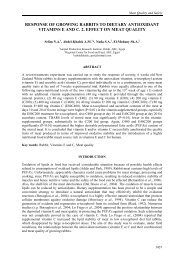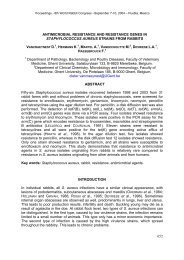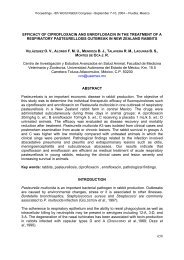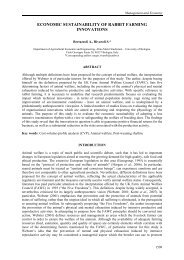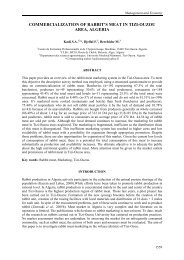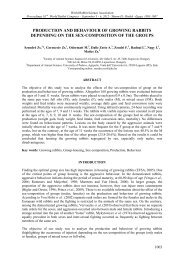Orheruata, A. M. - World Rabbit Science Association
Orheruata, A. M. - World Rabbit Science Association
Orheruata, A. M. - World Rabbit Science Association
Create successful ePaper yourself
Turn your PDF publications into a flip-book with our unique Google optimized e-Paper software.
<strong>World</strong> <strong>Rabbit</strong> <strong>Science</strong> <strong>Association</strong><br />
Proceedings 10 th <strong>World</strong> <strong>Rabbit</strong> Congress – September 3 - 6, 2012– Sharm El- Sheikh –Egypt, 603 - 606<br />
GROWTH PERFORMANCE OF RABBITS UNDER DIETARY<br />
MANIPULATION AT DIFFERENT POST WEANING AGES<br />
FOR HEAVIER BODY WEIGHTS<br />
<strong>Orheruata</strong>, A. M., Bello-Onaghise, G., Omoyakhi, J. M.<br />
Department of Animal <strong>Science</strong>, University of Benin, P. M. B. 1154, Benin City, Nigeria.<br />
Email- maorheruata@yahoo.co.uk or micorhe@uniben.edu<br />
ABSTRACT<br />
This study was conducted to determine the effect of dietary manipulation of growth in rabbits at<br />
different post-weaning ages on body weight (BW) at sexual maturity. A diet of 12%CP and 3238 kcal<br />
ME/kg was formulated as the control diet while another diet of 16%CP and 2906kcal ME/kg was<br />
formulated as the experimental diet. Dietary treatments were as follows: Treatment 1: 16% CP diet<br />
given between weaning (4 weeks) and8 weeks of age, Treatment 2:16% CP diet given between8and 12<br />
weeks of age, Treatment 3: 16% CP diet given between 12and 16 weeks of age, and Treatment<br />
4:control diet of 12% CP which was fed from weaning to 24 weeks of age. Besides, forage was also<br />
supplied. The BW records from 40 animals (10 per treatment) were collected from weaning to 24<br />
weeks of age. Results showed significant differences in BW of the rabbits from 12 weeks of age<br />
onwards, with those in Treatment 2 and Treatment 1 having the highest and the lowest BW,<br />
respectively. Results of the study therefore revealed that the adoption of the management practice of<br />
manipulating growth through feeding between 8 and 12 weeks of age will result in the production of<br />
table size rabbits of 1.464 kg and 1.655 kg at 16 and 20 weeks of age, respectively.<br />
Key words: <strong>Rabbit</strong>, post-weaning growth, diet.<br />
INTRODUCTION<br />
The meat supply situation in Nigeria remains critical in spite of the large animal population<br />
FMEDR(2000). It is also true that enormous investments of money, energy and time have been<br />
directed towards research and development efforts in the conventional livestock which has not<br />
adequately arrested the shortage. This implies that efforts should be placed on livestock species with<br />
short generation interval and high prolificacy and fecundity. One of such high potential source of<br />
animal protein is the rabbit, not commonly exploited in Nigeria even though Nigeria is one of the<br />
major producing nations in Africa (Lebas et al., 1997). Moreover, the domestic rabbits in Nigeria<br />
without the application of breeding programs are generally poor in performance (Umesiobi, 2000).<br />
This has prompted rabbit research in Nigeria where studies have reported values ranging from<br />
1483±91 to 1625±76g for rabbit weights at 20 weeks of age(<strong>Orheruata</strong> and Ekhiogbe, 2009). To be<br />
able to attain such weight at much younger age, dietary manipulation of growth studies for heavier<br />
weights at younger ages could be useful.<br />
Studies on manipulation of growth at compensatory growth phases have been reported in cattle, sheep,<br />
turkey and broilers (Lee and Leeson, 2001;Rozemboimetal., 2004; Halevy et al., 2006). The idea<br />
behind manipulation of growth at compensatory growth phase is that the animals are made to<br />
maximize their growth at this critical phase of growth, thus allowing the animal to exploit its full<br />
genetic growth potential. <strong>Orheruata</strong> and Ekhoigbe (2009) in their study on evaluating methods of<br />
manipulating growth and the time to manipulate the rabbits observed that the feeding pattern exerts the<br />
greatest influence and appropriate age of compensatory growth was between 1 and 2 months postweaning.<br />
It is this relatively short period of time that manipulation can be done for maximum effect in<br />
rabbits.<br />
603
Nutrition<br />
This study was therefore carried out to examine the effect of dietary manipulation of rabbits at<br />
different post-weaning ages on subsequent body weight.<br />
Experimental site<br />
MATERIALS AND METHODS<br />
The experiment was carried out in the rabbit unit of the University of Benin - Teaching and Research<br />
Farm, Benin City, Nigeria, located between latitudes 6ºand 6.30º N of the equator and longitudes 5.40º<br />
and 6ºE of the Greenwich Meridian. In the humid rainforest zone of Nigeria, annual temperature<br />
ranges between 24.5and 32.7 ºC with a mean value of 27.6 ºC. Annual rainfall ranges from 1498to<br />
3574mm with a mean value of 2162 mm. The relative humidity and daily sunshine are between 63.3<br />
and 81.71% and 5.85 and 7.5 hours with mean values of 72.5% and 6.68hours, respectively<br />
(NAA,2010).<br />
Animals, experimental diets and procedures<br />
Forty 28 days old weaned rabbits with average weight of 0.321±0.095kg from heterogeneous<br />
population (crosses of New Zealand White, New Zealand Red, Chinchilla, Californian, and Dutch<br />
breeds) were sourced from rabbit breeders in Benin City and in the Northern part of Nigeria and<br />
randomly allocated to four different dietary treatments (10/treatment).<br />
A diet of 12% CP and 3238kcalME/kg was formulated as the control diet while another diet of 16%<br />
CP and 2906kcalME/kg was formulated as the experimental diet. The composition and estimated<br />
values of the diets are presented in Table 1. Dietary treatments were as follows: Treatment 1:16% CP<br />
diet given between weaning (4 weeks) and 8 weeks of age, Treatment 2: 16% CP diet given between 8<br />
and 12 weeks of age, Treatment 3: 16 % CP diet given between 12 and 16 weeks of age, and<br />
Treatment 4: control diet of 12 % CP, which was fed from weaning to 24 weeks of age. The control<br />
diet was fed at all other times when the experimental diet was not being fed to 24 weeks of age. In all<br />
treatments, forage (a mixture of grasses and legumes: Panicum maximum, Tridax procumbens, Ipomea<br />
batatas leaves and Centrosema pubescens) was made available in the hutch.<br />
Table 1: Composition of the diets.<br />
Feed ingredients (%) Experimental diet Control diet<br />
Maize 60.00 84.00<br />
Groundnut cake 16.00 10.00<br />
Palm kernel cake 6.00 2.00<br />
Brewer’s dry grain 14.00<br />
Bone meal 2.50 2.50<br />
Limestone 1.00 1.00<br />
Vitamin premix 0.15 0.15<br />
Salt 0.35 0.35<br />
Estimated composition (%)<br />
Metabolizable energy (kcal/kg) 2,906 3,238<br />
Crude protein 16.21 12.38<br />
Ether extract 4.4 3.95<br />
Crude fibre 6.87 3.33<br />
Minerals (ash) 2.28 1.56<br />
Nitrogen free extract 57.63 66.70<br />
Individual body weights(BW) were weekly taken from weaning to 24 weeks of age using a 5 kg<br />
capacity kitchen scale. Weight data were subjected to analysis of variance using the GLM procedure<br />
of SAS (2004) to determine the effects of dietary treatment on BW at different post-weaning ages.<br />
604
10 th <strong>World</strong> <strong>Rabbit</strong> Congress – September 3 - 6, 2012– Sharm El- Sheikh –Egypt<br />
RESULTS<br />
Table 2: Body weights (BW) of rabbits at 8, 12, 16, 20 and 24 weeks of age.<br />
Dietary treatment BWT8 BWT12 BWT16 BWT20 BWT24<br />
1 0.523 0.615 b 0.960 b 1.200 b 1.255 c<br />
2 0.455 0.952 a 1.464 a 1.655 a 1.872 a<br />
3 0.438 0.775 ab 1.255 ab 1.295 b 1.520 b<br />
4 0.480 0.748 ab 1.295 ab 1.594 a 1.630 b<br />
SEM 0.031 0.043 0.115 0.042 0.050<br />
abc Means in the same column with different letters are significantly different (P
Nutrition<br />
Rozenboim L., Biran L., Chaiseha Y., Yahav S., Rosentrauch A., Sklan D., Halevy O. 2004. The effect of green and blue<br />
monochromatic light combination on broiler growth and development. Poultry Sci. 83, 842-845.<br />
SAS. 2004. SAS/STAT User’s Guide. Statistics. SAS Inst., Inc. Cary, NC, USA.<br />
Taiwo A.A., Adejuyigbe A.D., Adebowale E.A., Oshotan J.S., David O.O. 2005. Performance and nutrient digestibility of<br />
weaned rabbits fed forages supplemented with concentrate. Nig. J. Anim. Prod. 32, 74-78.<br />
Umesiobi D.O. 2000. Animal Production. I. Basic principles and practices. Ben Blaise Publications, Owerri, Nigeria.<br />
606


